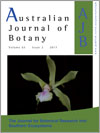Australian Journal of Botany
Volume 65
Number 3 2017
Gleditsia triacanthos is a woody exotic species that colonises different ecosystems in several countries around the world. In this work we review numerous studies about its invasion to show its importance as an invasive species in Argentina. Since the end of the 18th century, G. triacanthos has spread across different ecoregions in Argentina affecting flora, fauna and ecosystem processes. Our review highlights the need to develop monitoring and control strategies for this invasive species.
The incidence of snow was largely constant between 1983 and 2013 at Mt Field and on other high mountains in Tasmania, but decreased on lower elevation alpine mountains, trends apparently caused by changes in atmospheric instability. At Mt Field, obligate snow patch species persisted during the same period and cushion plants and shrubs increased.
In this paper we report on studies of the reproduction biology of an Amazonian orchid pollinated by Centridini bees that search for nectar on flowers. To our knowledge, this is the first report of reward production in Encyclia. This discovery provides new insights on the function of the cuniculus in Laeliinae, and sheds light on the evolution of floral rewards and pollination mechanisms within this diverse group of Neotropical orchids.
This study is the first embryological report on male structures in the genus Cephalanthus. It includes the analysis of anther development, both the study of the processes leading to the formation of pollen and the histology of the wall of the anther, describing how dehiscence occurs. The results contribute to future studies in other genera of the tribe Naucleeae in the Rubiaceae family.
Physical dormancy prevents immediate germination of seed and allows species to maintain a persistent soil seed bank providing the resource for post-fire recovery of plant populations. Temperature is a key driver for dormancy release but hot summer temperatures can result in rupture of the seed coat in the inter-fire period. Gradual leakage of seed from the seed bank under a warming climate may compromise the risk-spreading ability afforded by hardseededness potentially reducing species capacity to recover from disturbance.
Eucalyptus camaldulensis is the most widely distributed Eucalyptus species both globally and in its native range. In the present study, we explored the natural variation in foliar terpene composition across its natural distribution in Australia and how elevated CO2 can affect the accumulation of terpenes. We found four chemical varieties dominated by different monoterpenes across the natural range. In addition, plants growing under elevated CO2 accumulated a lower concentration of monoterpenes, suggesting that climate change can affect terpene accumulation in natural populations and plantations.
We investigated the demographic, dispersal and predation dynamics of an endangered rainforest shrub, Triunia robusta (Proteaceae). A life cohort table was developed from field demographic data, the potential dispersal distance was assessed and the effects of predation on seed and seedling mortality were quantified. It was found that T. robusta has limited dispersal, high post-predation mortality rates and relatively low reproductive rates, suggesting that critically small and isolated populations may be highly vulnerable.
Germination of fire-prone plant species can be complex. Understanding this key component of the regeneration niche can help elucidate mechanisms for persistence and inform conservation. Like many threatened species in fire-prone south-eastern Australia, Asterolasia buxifolia is restricted to riparian habitats. Germination ecology of this physiologically dormant family (Rutaceae) is not well understood. We found that seeds germinated only with smoke at winter temperatures. Darkness inhibited germination. These results help us understand why such species may be limited to riparian habitat.
Measuring xylem conduit length and distribution is important but tedious, and so it is often avoided. For decades, several measurement techniques have been debated, so we compared four classic methods and found none to be significantly different; however, we recommend the Christman method because it ensures ease of calculation. Accurate calculation of conduit length is crucial for many reasons, including comparison of global datasets on the potential plasticity of xylem characteristics, which is important information in a changing climate.




